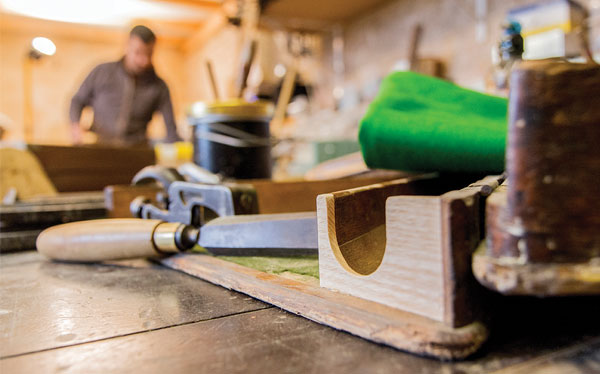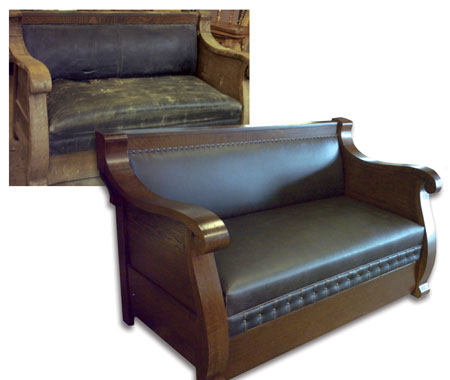Furniture finesse
 Rounded edges, smooth lines, intricate handiwork, keepsake stitches, bold patterns, touchable textures, simple stains, colorful hues and memorable etchings. A favorite piece of furniture can include some or all of these things. Whether it’s a naugahyde keeper or a turn-of-the-century heirloom filled with stories, one man’s trash can be another’s treasure. Breathing new life into the furniture of the past — or even more recent years — has become the pursuit of area preservationists who specialize in upholstery, repair and restoration.
Rounded edges, smooth lines, intricate handiwork, keepsake stitches, bold patterns, touchable textures, simple stains, colorful hues and memorable etchings. A favorite piece of furniture can include some or all of these things. Whether it’s a naugahyde keeper or a turn-of-the-century heirloom filled with stories, one man’s trash can be another’s treasure. Breathing new life into the furniture of the past — or even more recent years — has become the pursuit of area preservationists who specialize in upholstery, repair and restoration.
“It’s a little more art than science,” says Dave Gardner, owner of Valley Stripping & Furniture Restoration in Appleton.
Items, mostly with sentimental value, are coming into area furniture refinishers. Pieces include items from Hoosier cabinets to dressers to tables and chairs to doors, windows, mirrors and buffets. Older furniture also is getting revamped in new ways. Doors can be turned into mirrors and dressers are being utilized as kitchen islands thanks to idea resources like Pinterest.
“Furniture refinishing has been around for a long time. Some of this has been in two to three times,” adds Gardner who sees everything from repairs to modifications. His business subcontracts out upholstery work to another business, but does offer expert caning and wicker services.
“Caning is a lost art so it’s nice to have that resource available,” says Kraig Ruhnke, caning and wicker expert at Valley Stripping & Furniture Restoration, who takes on those labor-intensive projects. A chair alone can take 12-15 hours to complete depending on the damage and whether the work involves hand weaving or sheet caning.
Angie Thede, owner of Angie’s Upholstery in Appleton, has seen all kinds of things stuffed into furniture — corn stalks, old newspapers, long johns, bib overalls and military uniforms for starters.
“In the newspaper was an exact picture of the sofa and how much it sold for at the time,” Thede recalls of an old issue she once unearthed from a piece she was worked on recovering.
She works on everything from residential furniture to commercial projects, including restaurant booths, kiosks, benches, exam tables and more. Of course, there are always board seats from chairs and stools, which is how Thede got her start in upholstery work. She will go six to seven months without seeing one and then they’ll pop up again at the holidays when people want to spruce things up, Thede shares. Tufted and pillow back wingback chairs, baby room rockers and sun room furniture also remain popular. Most often, Thede sees heirloom pieces, but they aren’t necessarily being recovered in period fabric. People also are seeking durable materials that stand up to sun and weather, along with being soap and water washable, she shares.
“To each his own,” Thede says, noting that in 18 years she has never seen a specific color or pattern that the majority of her customers requested. “They’re (customers) going completely all over the board.”
Furniture restoration can cost more than today’s modern designs by about double depending on the work, but when done properly it also lasts longer due to the materials it was made with, says Robert Reynebeau who sees a lot of couches and chairs come through the business he once owned. He learned the trade from his father.
Reynebeau Upholstery & Auto Trim in Appleton was started in 1931 by Edmund Reynebeau, Robert’s father, and is owned today by Adam Stuyvenberg, a long-time employee. When the business began, the elder Reynebeau was doing 90 percent furniture work and the occasional tractor seat, Robert shared with a chuckle. Today, it’s about 35 percent furniture and 65 percent auto upholstery work on vehicles from 1910 to present day. The business also has done work on airplanes. There is, however, a misconception that upholsterers who do automobile work don’t know how to do furniture repair, Robert says. In fact, he notes it’s almost the opposite based on his experience. Today, after 40 years in the business, Robert works part time.
“It takes so much patience and time to do a project properly,” he notes.
Solid wood holds up better than thin veneer that will eventually fall apart, says Robert. He also sees furniture constructed with cardboard and plastic frames that will last maybe three to five years, and has already taken furniture down to the bare frame and rebuilt it while correcting problems along the way.
“It has to be something you like,” offers Robert. “But, now they have a quality piece of furniture that will last.”
Mark Pfister, owner of The Restoration in Menasha, echoes this sentiment. He notes that today’s tabletops, for examples, don’t hold up to long-term use because woods are no longer nurtured like they once were.
“The important thing is that they like it and it could go back three to four generations,” he says of pieces that come into his shop. “It’s not the kind of business that everyone would have the same interest in. … When it’s sentimental, it means more to me when I’m working on it.”
He started working with restoring, refinishing and preserving pieces from the past in 1980. He initially bought and sold antiques before working in both realms for a few years and then eventually moving over to what he continues to do today.
“Over the years, I’ve done just about everything,” shares Pfister. He estimates he’s done thousands of pieces in 35 years and does everything by hand.
“I try to preserve what’s there and work with it,” he adds. Pfister works with varnish, lacquer, oil, wax, shellac and painted finishes. He also will fill in what’s missing the best he can and uses an epoxy composite or wood to finish out pattern work and other areas that might have broken or come off during years of wear and tear.
“The craft can be very sophisticated and it can be very simple,” he explains. In addition to typical furniture pieces, Pfister also has done work on clocks and pianos. He finds this work to be particularly challenging and rewarding due to the precision involved.
One such project involved a square Steinway piano from the 1870s that the New Holstein Historical Society approached him about. The piano was found to have belonged to the family who settled the area.
“It was really a pretty piece when it was all done,” shares Pfister of the rosewood beauty. “It’s extensive work and very gratifying work when you’re working on something that big.” A customer once told Pfister that he was conserving the past and should be proud that he was able to give an object new life. Pfister has been known to rescue pieces from the curb as well.
To determine if a client wants to invest in saving a piece, Gardner typically starts by discussing expectations. Some clients may want to use the item, while others would like it for show. The same goes for scratches, cracks, scribbles and the color.
A piece is then stripped, sanded, prepped and stained, and finished with a top coat. Client conversations may be necessary once the work is in progress as well, Gardner shares.
Sometimes “sticker shock” can scare off clients, but email and being able to send in photos has helped area businesses in weeding out inquiries from actual jobs. At the end of the day, labor is the highest cost involved in furniture restoration, according to area experts.
“A lot of times it doesn’t matter to them how much it’s going to cost. They just want it done right,” shares Pfister. “I’m surprised by how many people appreciate the construction of things and how it’s put together.”
Some projects, however, come in and it’s questionable whether it can be saved.
For Ruhnke, that piece was a red rocking chair.
“Every one of us said we should throw it in the fire, but it came out beautifully,” he says.
Thede also has had her moments with certain fabrics that don’t want to cooperate or match up due to a print.
“There are times that I’m working on things that I just have to walk away,” she confesses.
What matters the most is when a piece can make someone smile or as Thede puts it, “when the people are so happy they come up and hug you.”
One such client for her was a gentleman in his 70s who brought in a faded mustard-colored chair that had been in his grandparents’ home. He wanted it recovered in the exact same color it once was and was able to locate a photograph that showed it in its original glory. Thede was able to bring back its luster.
“They’re happy I just gave them their memories back,” she says of those clients with a smile.
—FC












Leave a Comment